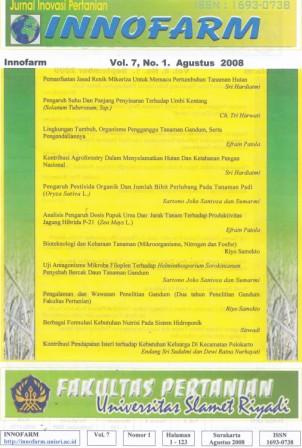PENGARUH PESTISIDA ORGANIK DAN JUMLAH BIBIT PERLUBANG PADA TANAMAN PADI (Oryza sativa L.)
DOI:
https://doi.org/10.33061/innofarm.v7i1.236Abstract
ABSTRACT
The aim of this research was to know the influence of organic pesticide and number of seedling per hole to the disease intensity of Brown Spot (Drechslera oryzae) on Rice Plant. "This research have been conducted on Apryl 26th until July 30th 2008 in Kateguhan village, Tawangsari subdistrik, Sukoharjo Regency, with the place hight 90 meters above the sea level and latosol of soil type.
This research used factorial method bassed on Randomized Completely Block Design (RCBD), consisted of two treatment factors and three replications. The first factor were kind of organic pesticide (M), consisted of four kind (M0= without of organic pesticide, M1 = using organic pesticide from leaf sirih, M2 = using organic pesticide from cayenne fruit and M3 = using organic pesticide from clove leaf). The second factor were number of see per hole (J) consisted of three level (J1 = 1 seedling/hole,       J2 = 2 seedling/hole and J3 = 3 seedling/ hole).
Parameters observed are the disease intensity Brown Spot, height of plant, fresh weight of biomass, dry weight of biomass, weight of grain per stool and weight of grain per plot.
Kind of organic pesticide treatment influence for the all parameters. Number of seedling per hole treatment influence for the all parameters. The are no interactions between kind of organic pesticide and Number of seedling per hole treatment for the all parameters. Disease intensity Brown Spot (Drechslera oryzae) lowest at treatment combination M3J2 (organic pesticide from clove flower and 2 seedling per hole), 3,33%. Weight of grain highest 1.77 g/plot (14,74 ton/ha), rached from treatment combination M3J2 (organic pesticide from clove flower and 2 seedling per hole).
Downloads
Published
Issue
Section
License
Authors who publish this journal agree to the following terms:
- Authors retain copyright and grant the journal right of first publication with the work simultaneously licensed under a Creative Commons Attribution License that allows others to share the work with an acknowledgement of the work's authorship and initial publication in this journal.
- Authors can separately make additional contractual arrangements for non-exclusive distribution published by the journal (e.g., publish it in a book), with an acknowledgement of its initial publication in this journal.
- Authors are allowed and encouraged to send their work via online (e.g., in the institutional repositories or their website) after published by the journal.


















